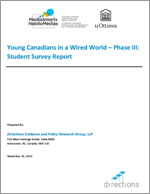Cyberbullying Overview
For most youth, the internet is all about socializing, and while most of these social interactions are positive, some use the technology to intimidate and harass others – a phenomenon known as cyberbullying.

For most youth, the internet is all about socializing, and while most of these social interactions are positive, some use the technology to intimidate and harass others – a phenomenon known as cyberbullying.

Verbal or emotional abuse is the most prevalent form of bullying online. Social bullying, another pervasive form – particularly with girls – includes social exclusion and spreading gossip and rumours.

It’s important to note that there is no single profile of a child who bullies. While some fit the traditional image of someone who is generally aggressive and has poor impulse control, others may be very sensitive to social nuances and are able to use that understanding against their targets. Others may be motivated simply by boredom.

Cyberbullying is everyone’s business and the best response is a pro-active or preventative one. From the outset, we can reduce the risks associated with internet use if we engage in an open discussion with our children about their online activities and set up rules that will grow along with them. Cyberbullying is strongly connected with moral disengagement – the ways we can fool ourselves into thinking it’s all right to do something we know is wrong or to not do something we know is right – so activating kids’ empathy and moral judgment is a key aspect of preventing both offline and online bullying.

Cyberbullying can be addressed under civil law or criminal law, based on the situation.

Learn more about our organization’s history.

Ottawa, ON (March 31, 2014) – Canadian youth are not as digitally literate as adults may think they are, according to new research released today by MediaSmarts. Though today’s young people have grown up immersed in digital media, they still rely on parents and teachers to help them advance their skills in areas such as searching and verifying online information.

 This report, written by Directions Evidence and Policy Research Group (Directions), details the results of a 2013 national survey of Canadian youth conducted by Directions on behalf of MediaSmarts. The classroom-based survey of 5,436 students in grades 4 through 11, in every province and territory, examined the role of networked technologies in young people’s lives.
This report, written by Directions Evidence and Policy Research Group (Directions), details the results of a 2013 national survey of Canadian youth conducted by Directions on behalf of MediaSmarts. The classroom-based survey of 5,436 students in grades 4 through 11, in every province and territory, examined the role of networked technologies in young people’s lives.

This report is drawn from a national survey of Canadian youth conducted by MediaSmarts in 2013. The classroom-based survey of 5,436 students in grades 4 through 11, in every province and territory, examined the role of networked technologies in young people’s lives. Experts or Amateurs?
